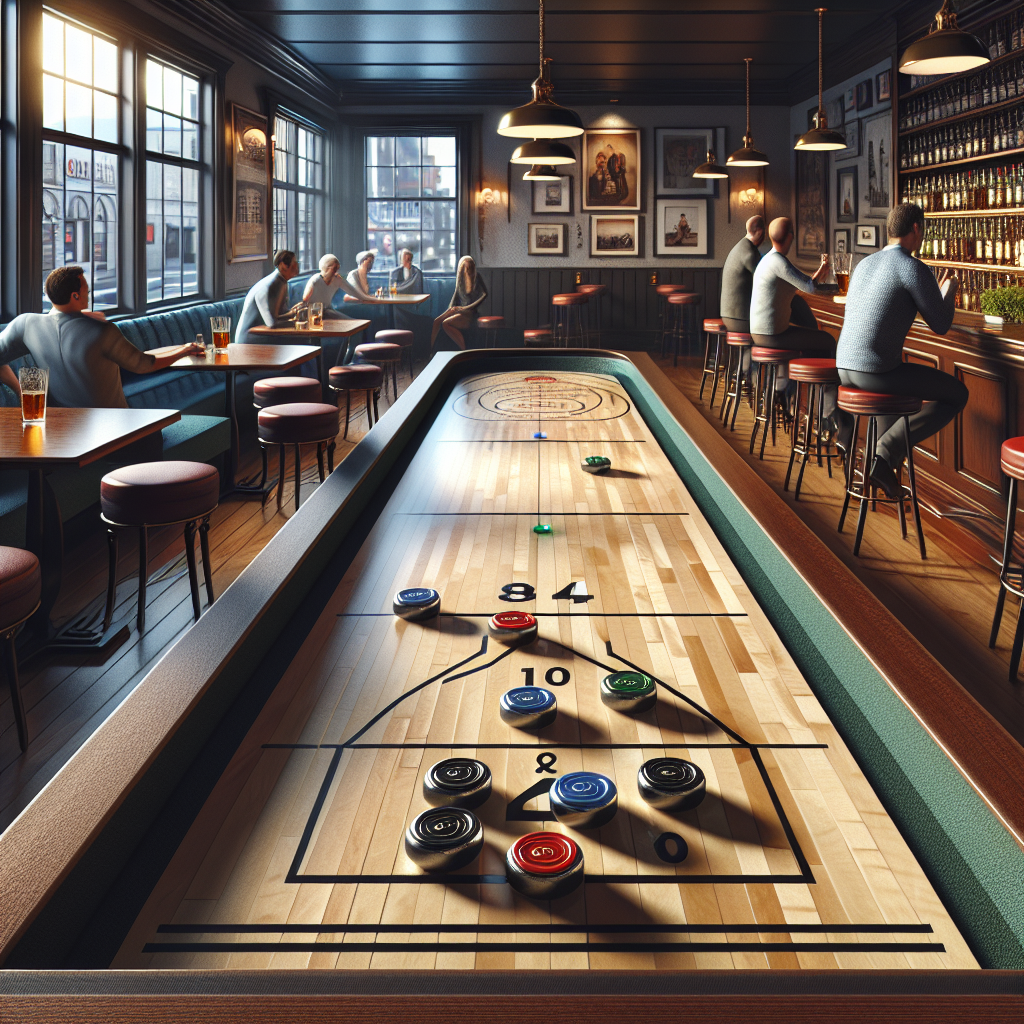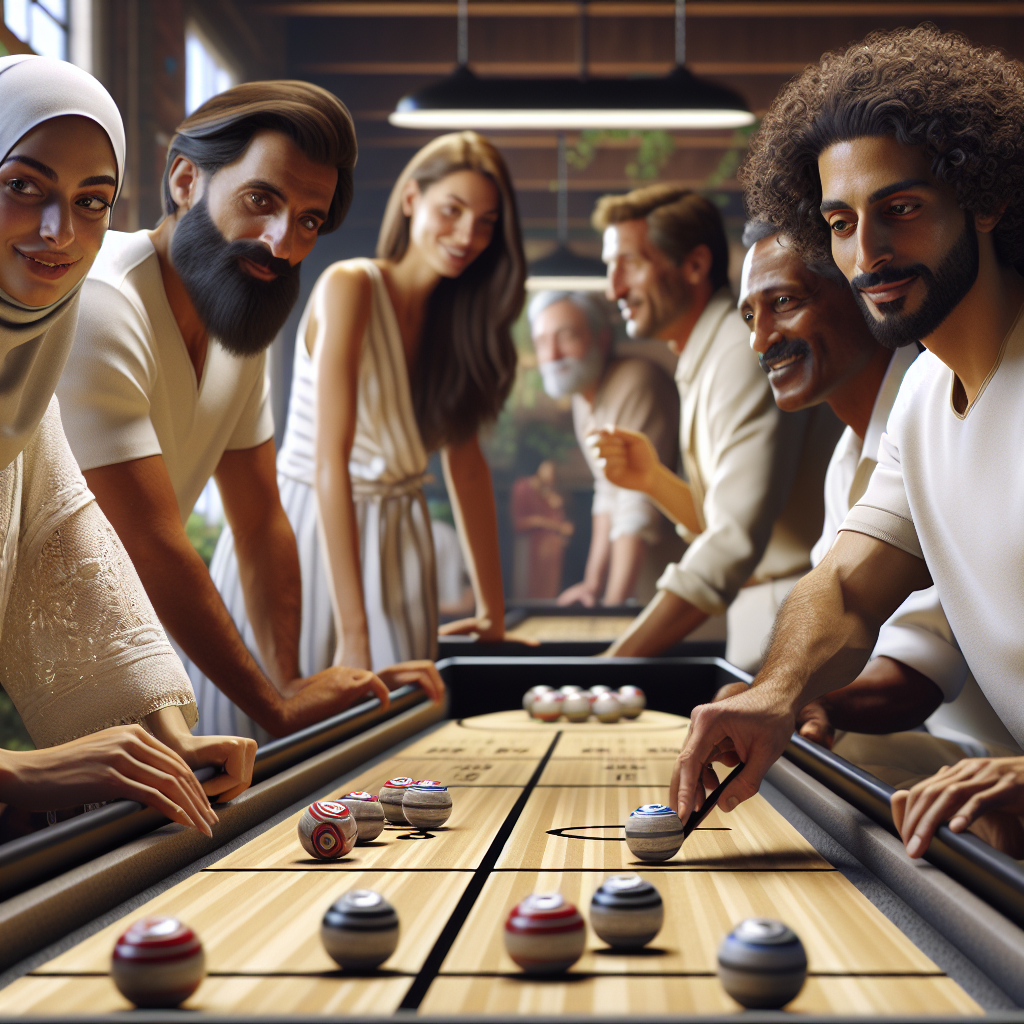The Basics of Bar Shuffleboard
Introduction to Bar Shuffleboard
Bar shuffleboard is a popular game that can be found in many bars and pubs, providing entertainment and friendly competition for adults. The game involves sliding weighted discs across a long, smooth table, aiming to land the discs in scoring areas to accumulate points. It’s a game that combines skill, strategy, and precision, making it enjoyable for players of all skill levels.
Originally believed to have its origins in England around the 1400s, bar shuffleboard has a rich history that can be traced back centuries. The game was known as “Shoffe-Groat” in England, where players would slide a large coin down a long table, attempting to get it as close to the edge as possible without falling off (Legacy Billiards). Over time, the game evolved and gained popularity among early American colonists, as mentioned in the play “The Crucible” which chronicles the Salem Witch Trials of the late 1600s (Legacy Billiards).
In 1848, a legal case known as The State vs. John Bishop ruled that shuffleboard was a game of skill rather than a game of chance, solidifying its place as a game that requires strategy and technique (Legacy Billiards). Since then, shuffleboard has become a beloved pastime enjoyed by many.
Origins and History of Bar Shuffleboard
The exact origins of bar shuffleboard may be difficult to pinpoint, but its roots can be traced back to ancient games played on tables with sliding components. These early games likely influenced the development of shuffleboard as we know it today.
The game’s popularity grew during the 20th century, particularly in North America, where it became a staple in bars and social clubs. Shuffleboard tables were introduced in various sizes to accommodate different spaces, but the official length of a shuffleboard table is twenty-two feet long by twenty inches wide, as established by official regulations (Legacy Billiards). However, tables can vary in length, usually falling within a range of 9 to 22 feet, while maintaining a width of at least 20 inches (Wikipedia).
The table’s surface is smooth and coated with a special wax or silicone-based material to reduce friction and allow the discs to glide easily. Some shuffleboard tables may have a concave or convex condition, adding an extra challenge to the game (Wikipedia).
Understanding the basics of bar shuffleboard is the first step toward enjoying this fun and competitive game. In the following sections, we will explore the rules, strategies, and variations of bar shuffleboard to help you become a skilled player.
How to Play Bar Shuffleboard
Getting familiar with the rules and gameplay of bar shuffleboard is essential to enjoy this popular social game. In this section, we will explore the objective of the game, scoring zones and points, as well as gameplay strategies and techniques.
Objective of the Game
The objective of bar shuffleboard is to slide, by hand, all four of one’s weights alternately against those of an opponent, aiming to reach the highest scoring area without falling off the end of the board into the alley. The most common form of the game, called Horse Collar, is typically played to either 15 or 21 points (Wikipedia). In shuffleboard tournaments, the game may be played to higher point thresholds.
Scoring Zones and Points
To understand how to score in bar shuffleboard, it’s important to familiarize yourself with the scoring zones on the shuffleboard table. The points awarded are based on where the weights come to rest on the table. Here’s a breakdown of the scoring zones and their corresponding points:
| Scoring Zone | Points |
|---|---|
| Between shuffleboard foul line and 1 line | 1 |
| 2 line | 2 |
| 3 line | 3 |
| 4 line | 4 |
| Hanger (special puck) | 5 |
The player whose weight(s) is farther down the board than their opponent’s weight(s) scores points. It is essential to outdistance the opponent’s weights or knock them off the board to be in a scoring position. To learn more about scoring and determining points, refer to our article on bar shuffleboard scoring.
Gameplay Strategies and Techniques
To excel in bar shuffleboard, players must develop effective gameplay strategies and techniques. Here are some tips to enhance your performance:
-
Mastering Disc Sliding Techniques: Practice controlling the speed, direction, and spin of your disc to achieve precision and accuracy. Experiment with different techniques, such as the “slide and drift” or the “tap and draw,” to gain an advantage over your opponent.
-
Understanding the Concept of the “Hammer”: The “hammer” refers to the player who has the final shot in each round. This position can be advantageous, as it allows you to potentially score the last points and determine the outcome of the round. Strategically plan your moves to secure the hammer position whenever possible.
-
Defensive Moves and Maintaining Control: In addition to aiming for high-scoring areas, consider defensive moves to block your opponent’s scoring opportunities. By strategically placing your weights, you can limit their chances of outdistancing or knocking off your weights.
-
Adapting to Changing Conditions: Shuffleboard tables can vary in terms of speed and surface conditions. Adapt your gameplay to the specific table you’re playing on. Experiment with different weights, angles, and techniques to account for variations in table conditions.
-
Observing Opponents and Cultivating Patience: Pay attention to your opponent’s moves and take note of their tendencies. This information can help you anticipate their strategies and adjust your gameplay accordingly. Patience is key in shuffleboard, as one well-executed move can completely change the course of the game.
By understanding the objective of the game, scoring zones and points, and implementing effective gameplay strategies and techniques, you can enhance your enjoyment and success in bar shuffleboard. Remember, practice makes perfect, so keep honing your skills and have fun competing with friends and fellow shuffleboard enthusiasts.
Different Variations of Bar Shuffleboard
Bar shuffleboard offers a variety of exciting game variations, each with its own set of rules and unique challenges. Let’s explore some of these popular variations:
Knock Off Shuffleboard Rules
In the classic version of knock off shuffleboard, two players compete to reach 15 points. Players take turns sliding weighted pucks down the table, aiming to outdistance their opponents or knock off their opponent’s pucks. The player whose puck is furthest down the table scores points based on different scoring zones. In this game, there are special pucks called hangers that are worth 5 points. The game ends when a player reaches 15 points. For a detailed explanation of the scoring zones and points, refer to our article on bar shuffleboard scoring.
Horse Collar Table Shuffleboard Rules
Horse collar shuffleboard is played to 51 points. Players take turns shooting the hammer shot, standing at opposite ends of the table throughout the game. Points are earned when pucks land beyond the foul line. Similar to knock off shuffleboard, there are hangers worth 13 or 26 points. The game continues until a player reaches 51 points holding the hammer, or the player who reaches 51 points with the hammer wins. For more information on this variation, check out our article on how to play bar shuffleboard (Shuffleboard City).
Tap & Draw Shuffleboard Rules
Tap & Draw shuffleboard adds a unique twist to the game. Players aim to tap their own puck or their opponent’s puck without knocking them off the table. The goal is to position the pucks strategically to maximize points. The scoring is based on specific zones on the table, and players need to employ different strategies to succeed in this variation. For more details on how to play this exciting shuffleboard variation, refer to our article on bar shuffleboard rules (McClure Tables).
Shuffleboard Crazy Eight Rules
Crazy Eight is an alternative shuffleboard game that adds a fun and challenging element to the traditional gameplay. In this variation, players shoot four pucks of the same color simultaneously across the table. To score, all four pucks must remain on the table past the foul line. If successful, the player shoots the remaining colored pucks one at a time, aiming to knock off the initial pucks while keeping at least one of the second colored pucks on the table past the foul line to earn points. This game requires precision and careful aim. Learn more about Crazy Eight and its rules in our article on bar shuffleboard rules (Shuffleboard City).
Target Table Shuffleboard Rules
Target-based shuffleboard games provide an additional layer of challenge and strategy to the classic game. Players must aim for specific targets on the shuffleboard table, and precision and strategy are crucial. The rules may vary depending on the specific target-based shuffleboard game being played. Explore different target-based shuffleboard games and their rules in our comprehensive article on bar shuffleboard rules (Gaming Blaze).
By understanding the rules of these different variations, you can have even more fun and excitement while playing bar shuffleboard. Experiment with different games to find your favorite and challenge your friends to a thrilling shuffleboard match.
Tips and Strategies for Bar Shuffleboard
To excel at bar shuffleboard, it’s important to develop effective strategies and master key techniques. By honing your skills and employing smart gameplay tactics, you can increase your chances of success. Here are some valuable tips and strategies to enhance your bar shuffleboard game:
Mastering Disc Sliding Techniques
Becoming proficient in disc sliding techniques is crucial for accurate and controlled shots. Practice your aim, speed, and release to ensure consistent and precise slides. Experiment with different grips and find the one that feels most comfortable for you. Remember to maintain a smooth and fluid motion while sliding the disc to minimize any unintended spin or wobble.
Understanding the Concept of the “Hammer”
In bar shuffleboard, the concept of the “hammer” refers to the last player or team to shoot in a round. Understanding the strategic advantage of the hammer is essential. As the hammer, you have the opportunity to gain an advantage by strategically placing your discs and potentially scoring higher points. Utilize the hammer to your advantage and aim to secure a strong position on the board during your final shot.
Defensive Moves and Maintaining Control
While scoring points is important, don’t underestimate the importance of defensive moves. Blocking your opponent’s scoring opportunities by strategically placing discs in their path can prevent them from accumulating points. By strategically positioning your discs, you can limit your opponent’s options, forcing them into difficult shots or even causing them to knock off their own discs.
Adapting to Changing Conditions
As you play bar shuffleboard, the playing surface may change due to humidity, temperature, and other factors. Be adaptable and adjust your techniques accordingly. Take note of any variations in disc speed and adjust your shots accordingly. By staying vigilant and adapting to changing conditions, you can maintain greater control over your shots and increase your chances of success.
Observing Opponents and Cultivating Patience
Observing your opponents’ gameplay can provide valuable insights into their strategies and weaknesses. Pay attention to their shot selection, disc placement, and overall approach. By analyzing their style and tendencies, you can adjust your own strategies accordingly. Additionally, cultivating patience is key to success in bar shuffleboard. Take your time to assess the board and plan your shots strategically. Rushing your shots can lead to mistakes and missed opportunities.
By implementing these tips and strategies, you can elevate your bar shuffleboard game and increase your chances of victory. Remember to practice regularly, analyze your gameplay, and continue to refine your skills. With dedication and a strategic mindset, you can become a formidable opponent in the exciting world of bar shuffleboard.
Common Mistakes to Avoid in Bar Shuffleboard
To excel in bar shuffleboard, it’s important to be aware of common mistakes that can hinder your gameplay. Avoiding these pitfalls will enhance your skills and increase your chances of success. Here are some common mistakes to avoid in bar shuffleboard:
Overwhelming Force and Lack of Strategy
One of the most common mistakes in bar shuffleboard is relying solely on overwhelming force without considering strategy. While power can be advantageous, it’s crucial to have a game plan and think strategically about each shot. Carefully consider the position of your pucks and plan your shots to maximize scoring opportunities. By combining strategy with controlled force, you can improve your chances of success.
Ignoring Defensive Play and Poor Positioning
Another mistake to avoid is ignoring defensive play and poor positioning. It’s essential to be mindful of your opponent’s pucks and strategically place your own pucks to block their scoring opportunities. By considering both offensive and defensive moves, you can gain an advantage in the game. Pay attention to the position of your opponent’s pucks and strategically position your own pucks to create obstacles and limit their scoring options (Shuffleboard City).
Lack of Patience and Losing Focus
Lack of patience and losing focus can significantly impact your performance in bar shuffleboard. It’s important to stay focused throughout the game and not rush your shots. Take your time to carefully plan your moves and make strategic decisions. Rushing can lead to errors and missed opportunities. Patience allows you to analyze the board, anticipate your opponent’s moves, and execute your shots with precision. Stay focused on the game and avoid distractions to maintain a competitive edge (Log Furniture and More).
Neglecting Table Maintenance
Neglecting table maintenance is another common mistake that can negatively impact your bar shuffleboard experience. Regularly cleaning and waxing the shuffleboard table is crucial to ensure a smooth playing surface and optimal puck glide. Neglecting maintenance can lead to inconsistencies in gameplay and hinder your performance. Take the time to clean the table surface and apply a suitable shuffleboard wax to maintain a consistent and enjoyable playing experience.
By avoiding these common mistakes, you can improve your bar shuffleboard skills and enhance your overall gameplay. Remember to strategize, consider defensive play, maintain focus, and prioritize table maintenance for optimal performance.
Shuffleboard Tournaments and Variations
Shuffleboard tournaments offer an exciting and competitive environment for shuffleboard enthusiasts to showcase their skills and engage in friendly competition. In addition to the traditional bar shuffleboard game, there are various tournament formats and game variations that add a unique twist to the gameplay. Let’s explore some of these shuffleboard tournaments and variations.
Team-Based Shuffleboard Tournaments
Team-based shuffleboard tournaments are a popular format that fosters camaraderie and teamwork among players. In these tournaments, teams compete against each other, combining individual talent with effective teamwork. This format adds an extra layer of strategy and competition, making it an engaging and dynamic experience for participants. For more information on how to play bar shuffleboard, check out our article on how to play bar shuffleboard.
Obstacle Course Shuffleboard
Obstacle Course Shuffleboard takes the classic game to new heights by introducing obstacles and challenges on a 9 ft shuffleboard table. This variation tests players’ skills in a thrilling and unpredictable environment. Overcoming obstacles adds excitement and helps develop strategic thinking and adaptability. It’s a must-try for shuffleboard enthusiasts looking for a unique and exhilarating experience. For more details on the dimensions and setup of the shuffleboard table, refer to our article on bar shuffleboard dimensions.
Speed Shuffleboard Challenge
Speed Shuffleboard Challenge adds an element of time pressure to the game. Players must complete their turns within a set time limit, adding an extra level of excitement and testing their physical and mental skills. This variation requires quick decision-making and precision while playing on a Playcraft shuffleboard table. It’s a thrilling way to enhance your shuffleboard experience.
Target-Based Shuffleboard Games
Target-Based Shuffleboard Games introduce specific targets on the shuffleboard table, adding an extra layer of challenge and strategy. Players must aim for these targets with their pucks, requiring precision and careful planning. These games test players’ accuracy and strategy, making each shot crucial for success. If you’re interested in target-based shuffleboard games, be sure to check out our article on bar shuffleboard scoring for more details.
Shuffleboard Bowling
Shuffleboard Bowling combines the precision of shuffleboard play with the strategy and technique of bowling. Players aim to slide their weighted pucks down the table, aiming to knock down as many pins as possible. Accuracy, control, and strategic decision-making are key in Shuffleboard Bowling. It’s a fun and challenging variation that adds a new dimension to the game.
Shuffleboard Golf
Shuffleboard Golf combines elements of shuffleboard and golf, creating an engaging game that requires skillful technique and strategic decision-making. Players aim to complete a series of “holes” by sliding discs along the table’s surface and landing them in designated scoring zones. Just like in golf, players must navigate obstacles and terrain variations, adding excitement and challenge to the game.
Shuffleboard Relay Races
Shuffleboard Relay Races add an element of teamwork and strategy to the game. Teams compete against each other, aiming to slide their pucks down the shuffleboard table and reach the designated scoring zones. In this format, each team member takes turns sliding one puck consecutively, requiring quick decision-making and effective communication as a team.
These shuffleboard tournaments and variations provide a diverse range of gameplay experiences for shuffleboard enthusiasts. Whether you enjoy team-based competition, obstacle courses, speed challenges, or target-based games, there is a shuffleboard variation that suits your preferences. Embrace the excitement and explore these variations to enhance your shuffleboard skills and enjoy the game in new and thrilling ways.







